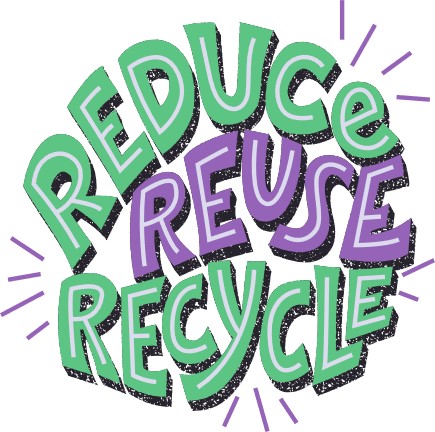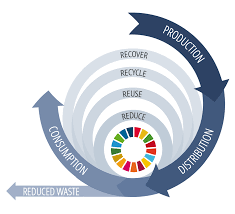Waste not, want not!
- Science-by-Trianon

- Jun 6, 2021
- 4 min read
Updated: Nov 19, 2021
Moving from one country or city to another generally brings many new experiences and is generally seen as enlightening.
When it comes to handling household waste a change of city or country can also be bewildering.
What was the yellow bag in the place you left may become a blue bin in the place you moved to and what you are allowed to put into the various bags or bins may also differ.

General framework and some comparisons
It is barely three months now that the EU has adopted its 'New Circular Economy Action Plan'.[1]
This plan places much emphasis on circular economy.
Every year, some 2.5 billion tonnes of waste are generated in the EU.
The lion's share of about a third of this stems from the construction industry, some 8.5% of it is household waste.[2]
Household waste is a complex beast. It contains a multitude of different materials (organic materials, wood & paper, plastics, ferrous metals & aluminium, textiles, glass, etc.) which may be present in (more or less) pure form (e.g. soup tins or drinks bottles) or as so-called compound materials in which various are glued together (e.g. milk cartons).

The general rule is that the purer the form in which a material is present the easier it is to recycle.
It is the declared aim of the EU to "move waste management up the 'waste hierarchy' (according to which waste prevention is the most favourable option, followed by preparing for reuse, recycling and other methods of recovery, and waste disposal is least favourable) and to follow the principles of a circular economy."[3]
That makes perfect sense and we could not agree more.
So, how well are we all doing in terms of generating and recycling household waste?
As the reference points required in order to answer that question we shall take the EU goals on household waste management.
These are a reuse and recycling rate for household waste of ≥ 55% and a landfill rate of ≤ 10%, both to be achieved by the year 2025.[2]
The waste data presented here is taken from Eurostat, the European Environment Agency, and the European Commission and refers to the years 2016-17,[2] the GDPs (Growth Domestic products) are taken from Statista.com and refer to the year 2019,[4] i.e. before the Corona crisis.

Table 1: GDPs and waste handling rates of European countries
The undisputed king in household waste generation is Denmark with 766 kg/capita/year, runners up are Malta and Cyprus at 640 kg/capita/year each.
On the other end of the scale we find Romania with 272 kg/capita/year.
It is tempting to relate the amount of household waste generated to the economic power of the various states, simply on the assumption that people who have got more spending power will buy more and thus generate more waste and, in general, this is found to be the case.
The correlation is, however, not as straightforward as the assumption outlined above, there are outliers which need to be explained.
While Denmark generates the highest amount of waste, in terms of wealth (here: the GDP) it is only average.
In terms of wealth, Cyprus and Malta rank at the bottom of the list, yet in terms of waste generation they share the second and third place.
This is tentatively attributed to the large role of tourism in these comparatively small countries.
Correlation between economic power and waste.
The correlation between economic power and waste becomes apparent when we look at the recycling and landfill rates, respectively.
Nine countries (Sweden, Belgium, Denmark, Finland, Germany, France, The Netherlands, Austria, and Luxembourg) already fulfil the landfill quota to be reached in 2025, i.e. ≤ 10%.
On the other hand, the recycling rate to be met in 2025 (≥ 55%) is at present only achieved by Germany, Austria, and Slovenia.
With the exception of the Germans and the Austrians this is not the same set of countries as for the landfill rate.

Why is this the case?
A closer examination of the data shows the sum of the recycling rate and the landfill rate to be less than 100%.
The gap can be up to almost 60% as in the case of Finland. Finland has got a recycling rate of 41% and a landfill rate of 1%.
So, where's the rest of the waste?
The answer is incineration.

The five countries with the highest incineration rates are the three Scandinavian countries (of the EU, i.e. Sweden, Denmark, and Finland) plus Estonia and Latvia.
In terms of the aforementioned waste hierarchy (prevention, reuse, recycling, and disposal) waste incineration is certainly to be ranked between recycling and disposal).
While energetic recovery (the fancy name for waste incineration) plays an important role in the waste management and the energy mix of some countries in terms of cyclic economy
it is not the best option, and not in terms of a country's CO2 balance.
How can we reduce our waste?
What we as ordinary consumers can do to help is to get involved, even in small ways.
The way to do that is to follow the waste hierarchy, i.e. avoid waste, reuse things, repair things, and dispose of what is left and cannot be taken care of in other ways.
Buy products that come in as little packaging as possible,
Buy products that come in single-material packaging as opposed to in compound materials,
Buy (where such alternatives exist) in zero-packaging shops, and
Sort your waste properly into the bags or bins or various colours (because it helps the waste sorting stations run smoothly & efficiently).
tl;dr:
Waste not, want not!
If you would like to know more about waste recycling or waste valourisation, subscribe to our newsletter:
If you would like to reduce or valourise waste in your business, contact us.
01) https://www.europarl.europa.eu/doceo/document/TA-9-2021-0040_EN.pdf
02) https://www.europarl.europa.eu/news/en/headlines/society/20180328STO00751/eu-waste-management-infographic-with-facts-and-figures
03) https://www.eea.europa.eu/data-and-maps/indicators/waste-recycling-1/assessment-1
04) https://www.statista.com/statistics/685925/gdp-of-european-countries/











Comments